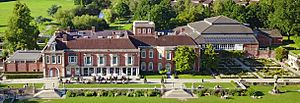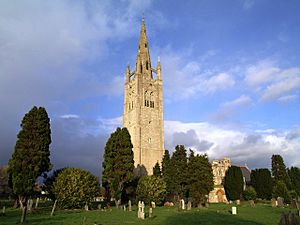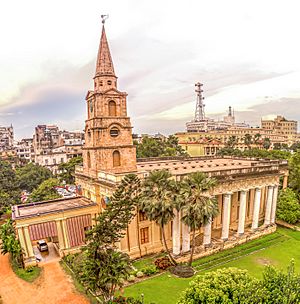Begum Johnson facts for kids
Frances Johnson (born Frances Croke; 10 April 1725/28 – 3 February 1812), also known as Begum Johnson, was a very important British resident in Bengal, India. She was known for being "universally beloved, respected and revered." She lived most of her long life in Calcutta, witnessing the start of British rule in Bengal in 1757 and its strong establishment by the early 1800s.
She passed away in Calcutta in 1812. In the same year, her grandson, Robert Jenkinson, 2nd Earl of Liverpool, became the Prime Minister of the United Kingdom. He held this high position for fifteen years (1812–27).
Contents
Early Life and Family
Frances Croke was born in South India. Her father, Edward Croke, was the Governor of Fort St. David, near Madras (now Chennai). Her mother, Isabella Beizor, was of Portuguese Indian heritage.
Frances spent her early years in South India and much of her later life in Eastern India (Bengal). Her sister, Sophia, married Alexander Wynch, whose granddaughter, Florentia Sale, wrote a famous book about events in Afghanistan.
First Three Marriages
Frances married for the first time when she was very young. Her husband was Parry Purpler Templer. They had two children, but sadly, her husband and both children died within a few years of their wedding.
Frances married a second time to James Altham, but he also passed away very soon after their wedding.
Two years later, when she was about 24, Frances married for the third time. On 24 March 1749, in Calcutta, she married William Watts. He was a senior official in the British East India Company. Their early marriage was peaceful.
However, the early 1750s brought political trouble in Bengal. Frances and her children were held captive during this time. The widow of Alivardi Khan, a local ruler, treated them kindly and kept them safe in the French town of Chandannagar.
The troubles ended with the Battle of Plassey in 1757. In 1758, Frances's husband, William Watts, received a large sum of money for his work. He decided to retire and move to England, a country Frances had never seen before. They bought a country estate near Bracknell, Berkshire, and built a large English country house called South Hill Park, which is now an arts centre. They were also buying Hanslope Park when William Watts died in August 1764. Their son, Edward, completed the purchase.
Return to India and Fourth Marriage
After William Watts died in 1764, Frances lived as a widow in England for five years. Once her children were grown up and settled, she made an unusual decision: she returned to India around 1769. The journey to India was long and took several months. It was rare for Englishwomen, especially widows in their mid-40s, to be in India at that time.
It's not fully clear why Frances went back. Perhaps she missed the familiar places and way of life she had known for most of her life. She was a wealthy woman, and her money went further in India than in England. She lived in a large house with many servants in Calcutta.
In 1772, a clergyman named Reverend William Johnson arrived in Calcutta. He was a chaplain for the British population. Frances, the wealthy widow, and William Johnson married in 1774. This marriage gave her the name she became famous for: Begum Johnson. Begum is an honorific title used in India for married women, showing they are respected.
Reverend Johnson was a very energetic man. Soon after arriving, he started a project to build Calcutta's first Anglican cathedral, now known as St. John's Church. It took many years to raise the money, but the foundation stone was laid in 1784, and the church was completed in 1787.
Later Life and Legacy
After the church was finished, Reverend Johnson wanted to return to England. However, Frances did not want to leave India, her home country. They decided to live apart. Frances offered William Johnson money if he would go to England without her and not return. They agreed it was best for them to part ways, as divorce was not possible then, especially for a clergyman.
Eyre Chatterton, an early Bishop of Nagpur, wrote in his 1924 book, A History of the Church of England in India:
In 1788 the Rev. William Johnson resigned his Chaplaincy after sixteen years in Calcutta, and returned to England. He had married in 1774, Mrs. Frances Watts, a lady who had previously buried three husbands. Her third husband had been a distinguished official. Possessed of considerable wealth, in addition to peculiar charm and ability which made her a great favourite in Calcutta, she had evidently not found Johnson indispensable to her life's happiness, so that when he left India on retirement, she decided to remain there..... In her will, she mentioned her husband by name, but left nothing to him.
Begum Johnson was 59 years old and never married again. Kathleen Blechynden wrote in her 1905 book, Calcutta: Past and Present:
It is not difficult to picture the old lady, in her hale old age, reclining among great cushions, waited on by attentive slave girls, enjoying the fragrant hookah, and telling over the oft-told tale of her experiences and adventures when under the protection of her friend the begum, whose title, so often on her lips, was turned by her friends in kindly jest into a soubriquet for herself. That the old lady was very particular about the observance of forms and ceremonies is shown by her having obtained from the Marquess of Wellesley the grant of a plot of ground, and permission that she might be buried in St. John's Churchyard, which had long been closed for interments, and also the promise that she should have a public funeral. When, in 1812, the time came for the fulfilment of these undertakings, Lord Wellesley had long vacated the Governor-Generalship, but his successor redeemed his pledge, and Begum Johnson was followed to her last resting-place by all the members of Calcutta society, headed by the Governor-General in his state coach, drawn by six horses, attended by the Body-Guard, and followed by the members of Council, and judges in their coaches.
She died in Calcutta on 3 February 1812. Her memorial in St. John's Church says she was "The oldest British resident in Bengal, universally beloved, respected and revered." In 1990, a book called The Calcutta of Begum Johnson was published, showing how important her name was to that era.
Descendants
Frances married four times and had children from at least two marriages. Only three of her children, all from her marriage to William Watts, lived to adulthood. All three of them had descendants who became important in politics and building the British Empire:
- Their daughter Amelia married Charles Jenkinson, a close advisor to King George III. Amelia died young, at age 19, shortly after giving birth to Robert. Robert grew up to become the Prime Minister of the United Kingdom.
- Their daughter Sophia married George Poyntz Ricketts. He became the governor of Tobago in 1793 and then of Barbados the next year. Their son, Charles Milner Ricketts, worked in India as a respected administrator and later became a Member of Parliament (MP) in England.
- Their only son, Edward Watts, lived at Hanslope Park. He married Florentia Wynch, whose family was connected to his mother's side.





